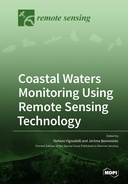Explore

Coastal Waters Monitoring Using Remote Sensing Technology
0 Ungluers have
Faved this Work
Login to Fave
Around 10% of the global population lives in the world’s coastal zones, mostly concentrated in the world’s largest megacities. In many regions, the population is exposed to a variety of natural hazards and space-based observations. This Special Issue will focus on the usage of remote sensing alone or in synergy with in situ measurments and modeling tools to provide precise and systematic information about processes acting in the world’s coastal zones.
This book is included in DOAB.
Why read this book? Have your say.
You must be logged in to comment.
Rights Information
Are you the author or publisher of this work? If so, you can claim it as yours by registering as an Unglue.it rights holder.Downloads
This work has been downloaded 96 times via unglue.it ebook links.
- 96 - pdf (CC BY) at Unglue.it.
Keywords
- ACOLITE
- ADG/CDOM colored dissolved organic matter
- aerial drone
- along-track interferometric synthetic aperture radar (ATI-SAR)
- Arctic Ocean
- Ariake Sea
- atmospheric correction
- azimuth ambiguity
- backscattering
- band registration
- baseline-to-platform speed ratio estimation
- bathymetry inversion
- black pixel assumption
- Black Sea
- C2RCC
- Chattonella spp.
- chlorophyll-a variability
- Climate Change Impact
- coastal flooding
- coastal geomorphology
- coastal ocean
- coastal processes
- coastal upwelling
- coastal urban centers
- coastal waters
- Copernicus Programme
- current line-of-sight (LOS) velocity
- diffuse attenuation coefficient
- empirical orthogonal function
- frontal zones
- GNSS
- GOCI
- harmful algal blooms
- HF marine radars
- high frequency radar
- Hurricanes
- image augmentation
- in situ measurements
- Inner Sea of Chiloé
- internal waves
- land subsidence
- Landsat-8 OLI
- LiDAR
- Management
- marine storms
- Mediterranean Sea
- Mekong Delta
- Micasense Rededge-M
- model data
- MODIS
- MODIS-Aqua
- morphological registration
- multi-scale monitoring
- multi-temporal approach
- multi-temporal SAR interferometry
- multispectral camera
- MUR SST
- Mzymta River
- Natural Hazards
- natural protected areas
- neural networks
- northern Patagonia
- ocean color
- ocean color data
- ocean surface circulation
- ocean tidal backwater
- ocean tide model
- Pearl River estuary
- physics-based inversion method
- phytoplankton remote sensing
- Puerto Rico
- Radon transform
- red tides
- Reference, information & interdisciplinary subjects
- relative sea level change
- Remote sensing
- Research & information: general
- river discharge
- river plume
- S-EOF
- satellite
- satellite altimetry
- satellite altimetry data
- satellite remote sensing
- satellite-derived bathymetry
- sea waves
- sea-surface height
- Sediment transport
- self-organizing map
- Sentinel 3
- Sentinel-2
- Sentinel-2 MSI
- Skeletonema spp.
- small river plume
- southwestern Puerto Rico
- spatial–temporal distribution
- spring–neap tides
- SST fronts
- stage–discharge relation
- steric-effect
- storm surge
- suspended particulate matter
- suspended sediment
- synoptic characteristics
- thema EDItEUR::G Reference, Information and Interdisciplinary subjects::GP Research and information: general
- time-series
- total suspended sediment
- turbid waters
- turbidity
- Typhoon Soudelor
- VIIRS
- Water quality
- wave energy
- wave radar
- wind forcing
Links
DOI: 10.3390/books978-3-0365-1233-4Editions

